If you’re looking to deepen your spiritual journey, exploring various meditation practices can be a rewarding way to connect with your inner self. From mindfulness to guided imagery, each offers unique benefits and insights. Let’s dive into some effective meditation techniques that can enhance your spiritual experience and help you find a sense of peace and clarity.
Zen Meditation for Clarity
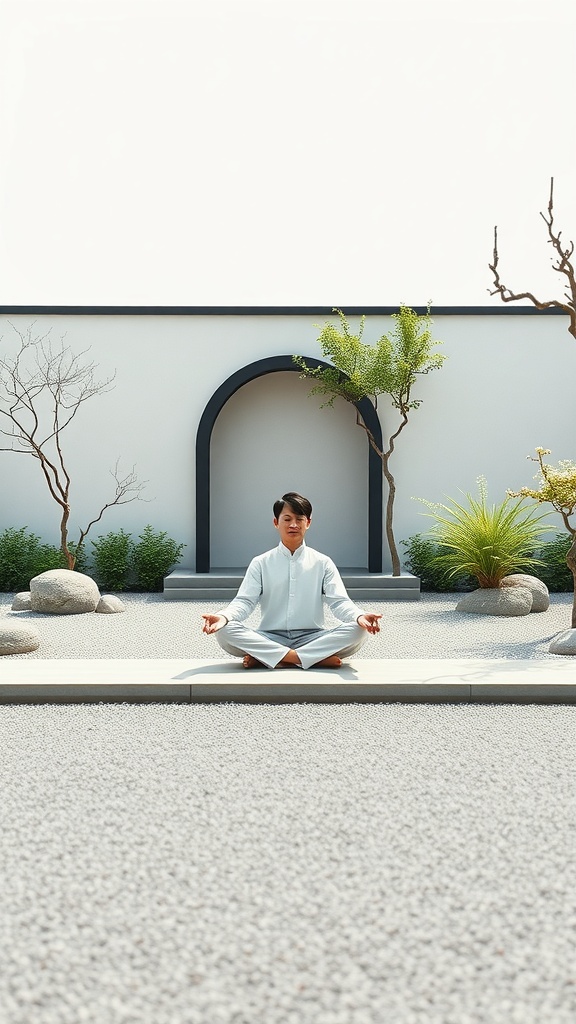
In the image, a young individual sits gracefully in a serene environment, embodying the essence of Zen meditation. The calm surroundings, complete with soft greenery and smooth stones, create a peaceful atmosphere perfect for introspection.
Zen meditation emphasizes simplicity and mindfulness. The individual’s relaxed posture and focused expression reflect a deep connection to the present moment. This practice encourages letting go of distractions and embracing clarity in thought.
To practice Zen meditation, find a quiet space where you feel comfortable. Sit in a relaxed position, close your eyes, and take deep breaths. Focus on your breath as it flows in and out. When thoughts arise, acknowledge them and gently return your focus to your breathing. This helps clear the mind and invites a sense of calm.
Incorporating Zen meditation into your daily routine can be beneficial. Even just a few minutes each day can help you cultivate clarity and peace within. Over time, you may find that it enhances your overall well-being and mindfulness.
Transcendental Meditation for Inner Peace

In a serene space filled with soft light and greenery, a person sits cross-legged on a yoga mat, embodying tranquility. The gentle glow from a lantern overhead creates a warm atmosphere, while the large windows let in natural light. This environment is perfect for practicing Transcendental Meditation (TM), a technique that encourages deep relaxation and mental clarity.
Transcendental Meditation is all about creating a peaceful inner world. It involves sitting comfortably, closing your eyes, and silently repeating a specific mantra. The goal is to settle into a state of profound rest while allowing thoughts to come and go without attachment. The calm, open surroundings in the image reflect the essence of this practice, inviting a sense of calm and focus.
Practicing TM can lead to a range of benefits. Many people experience reduced stress, improved emotional well-being, and greater clarity of thought. The peaceful ambiance depicted in the image enhances the effectiveness of meditation, showing how a tranquil space can foster mindfulness and relaxation.
For anyone looking to dive into Transcendental Meditation, setting up a dedicated space is key. Consider soft lighting, comfortable seating, and elements of nature, like plants, to create a calming environment. With the right space and a commitment to practice, achieving inner peace through TM can become a treasured part of your daily routine.
Walking Meditation for Grounding
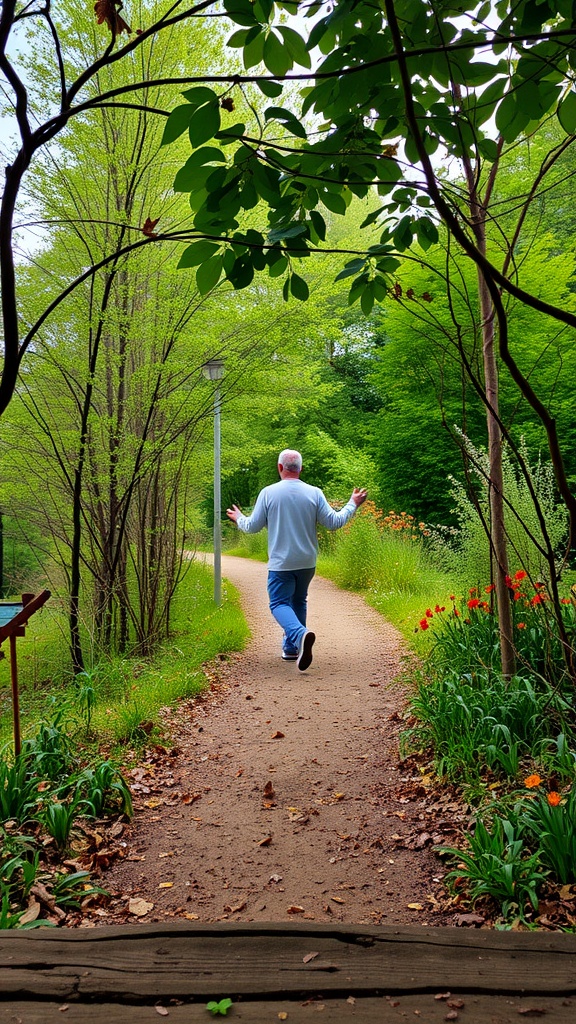
Walking meditation is a beautiful practice that combines the benefits of mindfulness with movement. In the image, we see a person walking down a peaceful path, surrounded by vibrant greenery and flowers. This serene environment enhances the experience, making it easier to connect with nature and oneself.
To begin a walking meditation, find a quiet place, like a park or garden. As you walk, focus on your breath and the sensations in your feet as they touch the ground. Feel the earth beneath you and take in the sights and sounds around you.
Notice how your body moves. This practice encourages awareness of each step, helping you feel more grounded. The lush trees and blooming flowers in the image remind us that nature can be a powerful ally in our journey towards inner peace.
You can also incorporate affirmations or simple phrases as you walk. This can help center your thoughts and deepen your connection to the moment. Walking meditation is not just about moving; it’s about being fully present in each step.
So next time you feel overwhelmed, take a moment to step outside. Embrace the rhythm of your footsteps and let the world around you calm your mind.
Loving-Kindness Meditation for Compassion
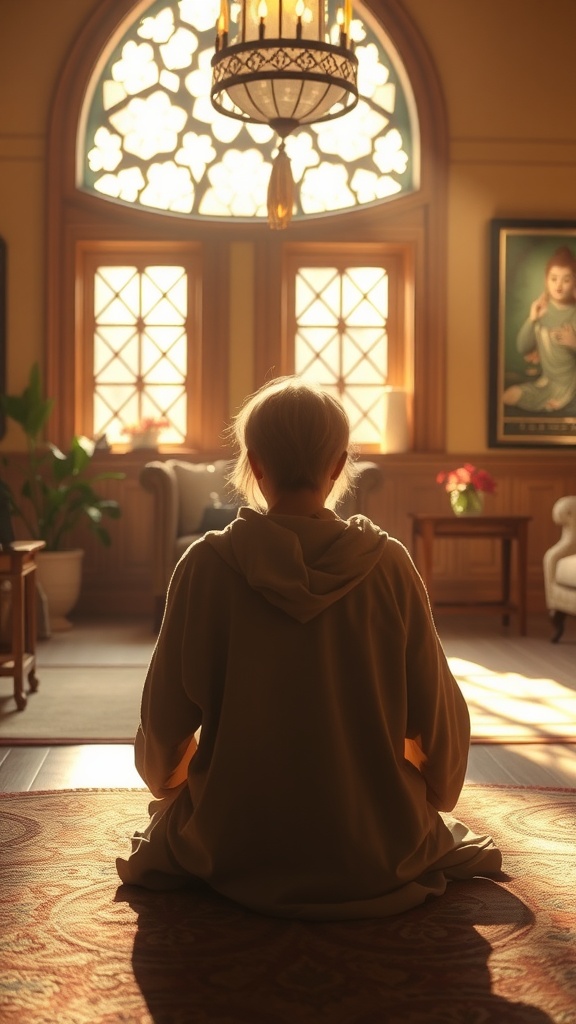
The image beautifully captures the essence of loving-kindness meditation, a practice focused on cultivating compassion towards oneself and others. In a serene setting, a person sits peacefully, emphasizing the tranquil atmosphere that is so vital for meditation. The soft light streaming through the stained glass windows adds a warm glow, creating a perfect backdrop for inner reflection.
This form of meditation encourages us to open our hearts and extend kindness not only to those we care about but also to strangers and even those we find challenging. By practicing loving-kindness meditation, we learn to break down barriers, allowing love and empathy to flow freely. It’s about nurturing a compassionate mindset, which can lead to deeper connections with ourselves and those around us.
To practice loving-kindness meditation, find a quiet place like the one depicted in the image. Sit comfortably and start by focusing on yourself. Silently repeat phrases such as, ‘May I be happy. May I be healthy. May I be safe. May I be at ease.’ Gradually extend these wishes to loved ones, acquaintances, and eventually to all beings. This practice not only fosters compassion but also brings a sense of peace and fulfillment.
Breath Awareness Meditation for Relaxation
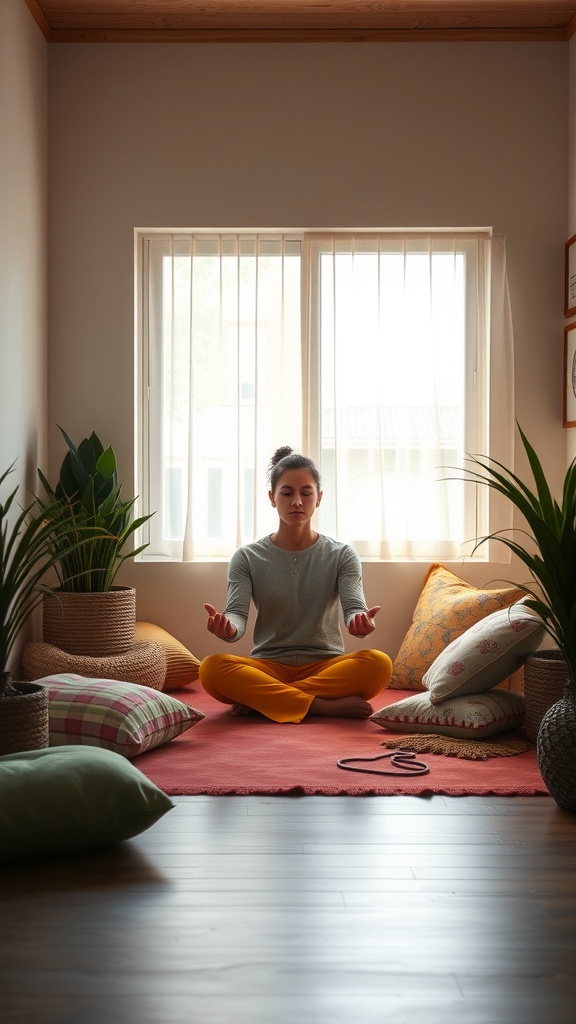
In the image, we see a peaceful setting where a person is engaging in breath awareness meditation. They are seated comfortably on a soft rug, surrounded by cushions and plants that create a calming atmosphere. The sunlight filters through the curtains, enhancing the serene environment.
Breath awareness meditation is a simple yet effective practice to bring relaxation and clarity into your life. By focusing on your breath, you can anchor yourself in the present moment. It helps reduce stress and anxiety, making it a great tool for anyone looking to unwind.
To start, find a quiet space like the one in the image. Sit comfortably, close your eyes, and take a deep breath in through your nose. Feel your chest and belly expand. Then, exhale slowly through your mouth. Repeat this process, allowing any distractions to fade away.
As you continue, notice the rhythm of your breathing. If your mind starts to wander, gently bring your attention back to your breath. This practice can be done for just a few minutes or longer, depending on your comfort level.
Overall, breath awareness meditation can be a valuable addition to your relaxation routine. It encourages mindfulness and can help you reconnect with yourself amidst a busy day.
Chakra Meditation for Energy Balance
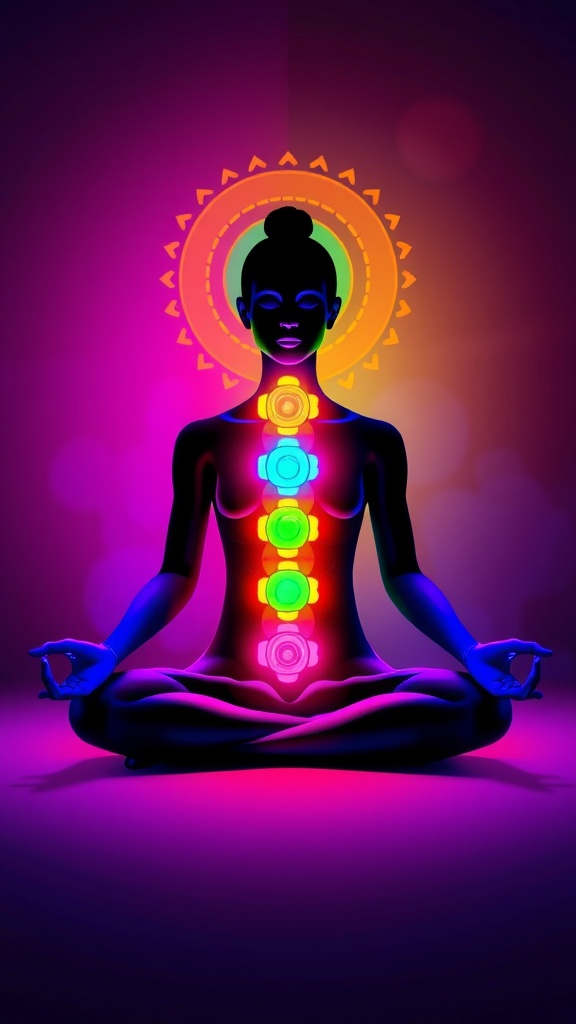
Chakra meditation is a beautiful practice that helps balance your energy centers. In this image, you can see a figure meditating, with vibrant colors representing the chakras. Each chakra is associated with different emotions and physical aspects, making it essential to keep them aligned.
The colors in the image—ranging from red to violet—represent the seven main chakras. Starting from the base of the spine, the root chakra is red, followed by the sacral, solar plexus, heart, throat, third eye, and crown chakras at the top. Each color vibrates at a different frequency, contributing to your overall energy.
During chakra meditation, focus on each chakra individually. As you breathe deeply, visualize the corresponding color filling that area of your body. This practice not only promotes relaxation but also helps release any stagnant energy, allowing for a flow of positivity and balance.
Guided Visualization for Manifestation

The image captures a serene moment of meditation, with a figure sitting peacefully under a glowing moon. Surrounding the moon are white birds flying through a starry sky, creating an atmosphere of tranquility and possibility.
This setup perfectly embodies the concept of guided visualization for manifestation. When you visualize, you tap into your imagination to create a mental picture of what you desire. This practice fosters a positive mindset and aligns your thoughts with your goals.
To engage in this practice, find a comfortable space where you can relax without distractions. Close your eyes and take a few deep breaths. Imagine the moon above you, radiating light and energy. Visualize the life you want to create—see it, feel it, and believe in its possibility.
As you continue, let your thoughts flow like the birds in the sky. Each breath can help lift your desires into the universe. Remember, visualization isn’t just daydreaming; it’s an active process that encourages you to connect deeply with your aspirations.
With regular practice, you may find that your visualizations become clearer and more vivid. This doesn’t just inspire hope; it can also help you take practical steps toward your goals. So, embrace this method and let your dreams take flight!
Mindfulness Meditation for Present Awareness
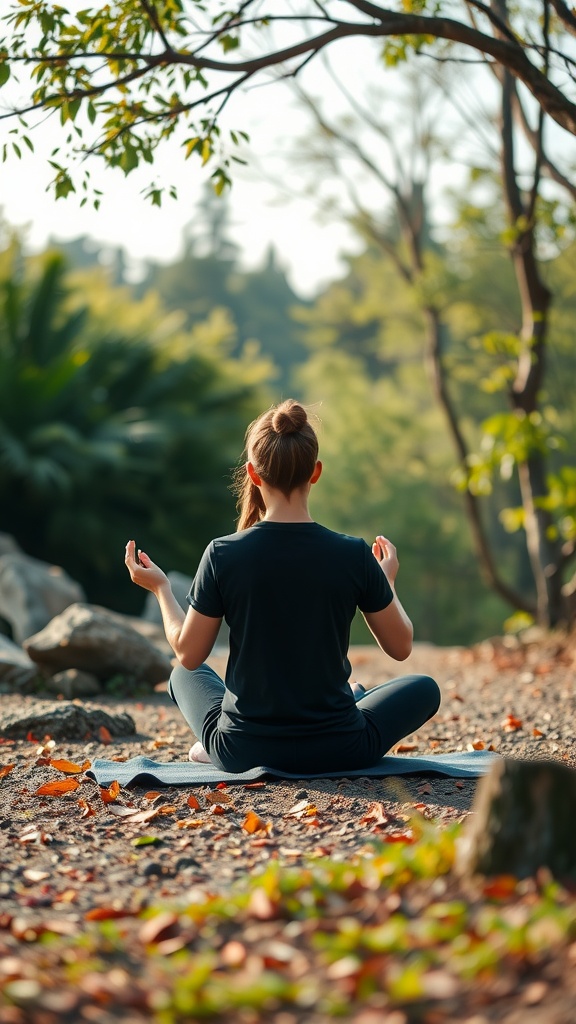
Mindfulness meditation is all about being in the moment. In the image, we see someone sitting peacefully on a textured mat, surrounded by nature. The person is in a relaxed posture, with hands resting in a meditative gesture. This setting emphasizes tranquility, encouraging a deep connection to the present. Colors of nature—green leaves and earthy tones—add to the calming atmosphere, making it a perfect backdrop for meditation. Practicing mindfulness helps you tune into your surroundings and your thoughts without judgment. You might focus on your breath or the sounds around you, which can create a sense of clarity and calm. This practice is accessible to everyone, and you can start with just a few minutes each day. Simply find a comfortable spot, close your eyes, and take a moment to notice how you feel. As you settle into your practice, try to let go of distractions. It’s normal for your mind to wander, but gently bringing your focus back to the present is key. Over time, you might notice your ability to stay present improving. With regular practice, mindfulness meditation can help reduce stress and enhance your overall well-being, making it a simple yet effective addition to your daily routine.
Sound Bath Meditation for Healing

Imagine yourself in a serene setting, surrounded by soothing sounds. This is the essence of sound bath meditation. In this practice, you immerse yourself in sound waves produced by various instruments like singing bowls and gongs. The vibrations resonate through your body, helping to release tension and promote relaxation.
The image captures a peaceful moment where a person enjoys a tranquil bath with candles and gentle water. This peaceful atmosphere enhances the meditative experience. When you combine the calming visuals with sound bath meditation, it creates a holistic healing environment.
As you sit back and let the sounds wash over you, focus on your breath. Allow the melodies to guide your thoughts away from stress. The water, like the sounds, can help you feel lighter and more connected to your inner self. To practice at home, consider lighting a candle, filling your space with gentle sounds, and letting yourself drift into calmness.
Journaling Meditation for Self-Reflection
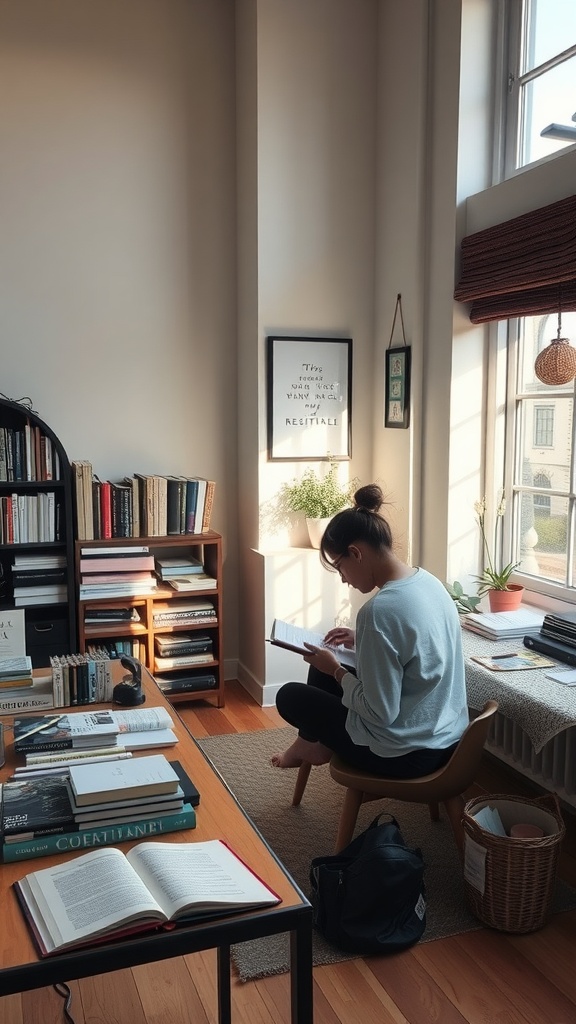
Imagine a cozy space filled with natural light, a gentle breeze, and the soothing presence of books around you. This image captures a peaceful moment where someone is engaged in journaling—an essential practice for self-reflection. With a notebook in hand, they sit quietly, absorbed in their thoughts, surrounded by a calming environment.
Journaling meditation combines the act of writing with a mindful approach. It’s about letting your thoughts flow onto the page without judgment. You can jot down your feelings, dreams, or even questions you have about life. This practice not only helps in clarifying your thoughts but also provides a sense of emotional release.
The setting shown in the image emphasizes tranquility. A small chair, a wooden table, and shelves lined with books create an inviting atmosphere. The natural light streaming in highlights the importance of a serene environment for effective reflection. A few plants add a touch of life, reminding us that growth is ongoing.
Setting aside time for journaling can help ground you. It’s a way to connect with your inner self and examine your experiences. You might start with just a few minutes each day. Grab a comfortable spot, like in the picture, and let your thoughts flow, allowing the act of writing to guide you on your journey of self-discovery.